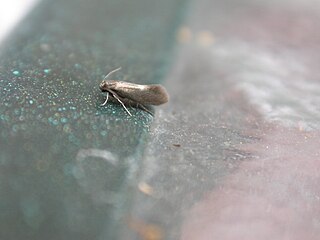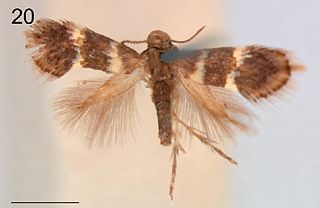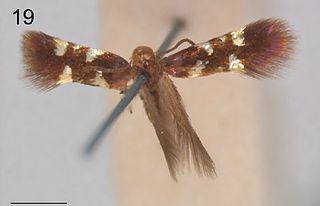
A family of primitive monotrysian moths in the order Lepidoptera, Heliozelidae are small, metallic day-flying moths with shiny smooth heads. In Europe the small adult moths are seldom noticed as they fly quite early in the spring. The larvae are leaf miners and the vacated leaf mines are distinctive because the larva leaves a large hole at the end.

Antispila ampelopsifoliella is a species of moth of the family Heliozelidae. It is found in eastern North America, including Connecticut, Kentucky, New York, Vermont and Ontario.Records from Italy may refer to Antispila oinophylla.

Antispila is a moth genus of the family Heliozelidae. It was described by Jacob Hübner in 1825.
Antispila ampelopsia is a moth of the family Heliozelidae. It was described by Kuroko in 1961. It is found in Japan.

Heliozela anna, the jamun leaf miner, is a moth of the family Heliozelidae. It was described by Thomas Bainbrigge Fletcher in 1920. It is found in India, including Bengal.
Antispila argentifera is a moth of the family Heliozelidae. It was described by Annette Frances Braun in 1927. It is found in North America, including Ontario.

Antispila argostoma is a moth of the family Heliozelidae. It was described by Edward Meyrick in 1916. It is found in India.
Heliozela argyrozona is a moth of the family Heliozelidae. It was described in the genus Antispila by Edward Meyrick in 1918 and moved to the genus Heliozela by Erik J. van Nieukerken and Henk Geertsema in 2015. It is found in South Africa.

Antispila aristarcha is a moth of the family Heliozelidae. It was described by Edward Meyrick in 1916. It is found in India.
Antispila cleyerella is a moth of the family Heliozelidae that is endemic to Japan.
Antispila cyclosema is a moth of the family Heliozelidae. It was described by Edward Meyrick in 1921. It is found in Brazil.
Antispila freemani is a moth of the family Heliozelidae. It was described by J. Donald Lafontaine in 1973. It is found in North America, including Ontario and British Columbia.
Antispila inouei is a moth of the family Heliozelidae. It was described by Kuroko in 1987. It is found in Japan.
Antispila isorrhythma is a moth of the family Heliozelidae. It was described by Edward Meyrick in 1926. It is found in India.

Holocacista micrarcha is a moth of the family Heliozelidae. It was described by Edward Meyrick in 1926. It is found in India.
Antispila nolckeni is a moth of the family Heliozelidae. It was described by Philipp Christoph Zeller in 1877. It is found in Colombia.
Antispila orthodelta is a moth of the family Heliozelidae. It was described by Edward Meyrick in 1931. It is found in Brazil.
Holocacista pariodelta is a moth of the family Heliozelidae. It was described by Edward Meyrick in 1929. It is found in India.

Holocacista selastis is a moth of the family Heliozelidae. It was described by Edward Meyrick in 1926. It is found in India.
Antispila uenoi is a moth of the family Heliozelidae. It was described by Kuroko in 1987. It is found in Japan. In 2018, the species was found from China.





